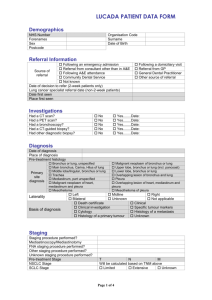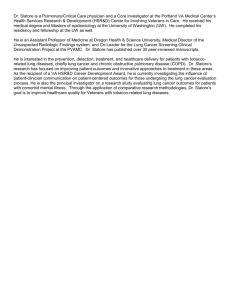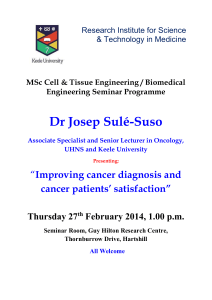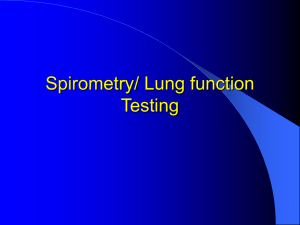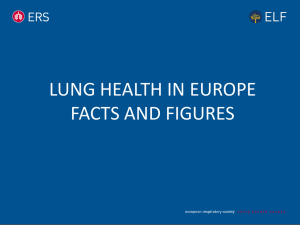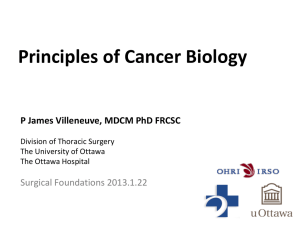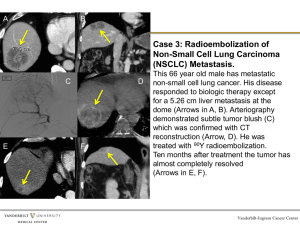EPQ first draft docx
advertisement
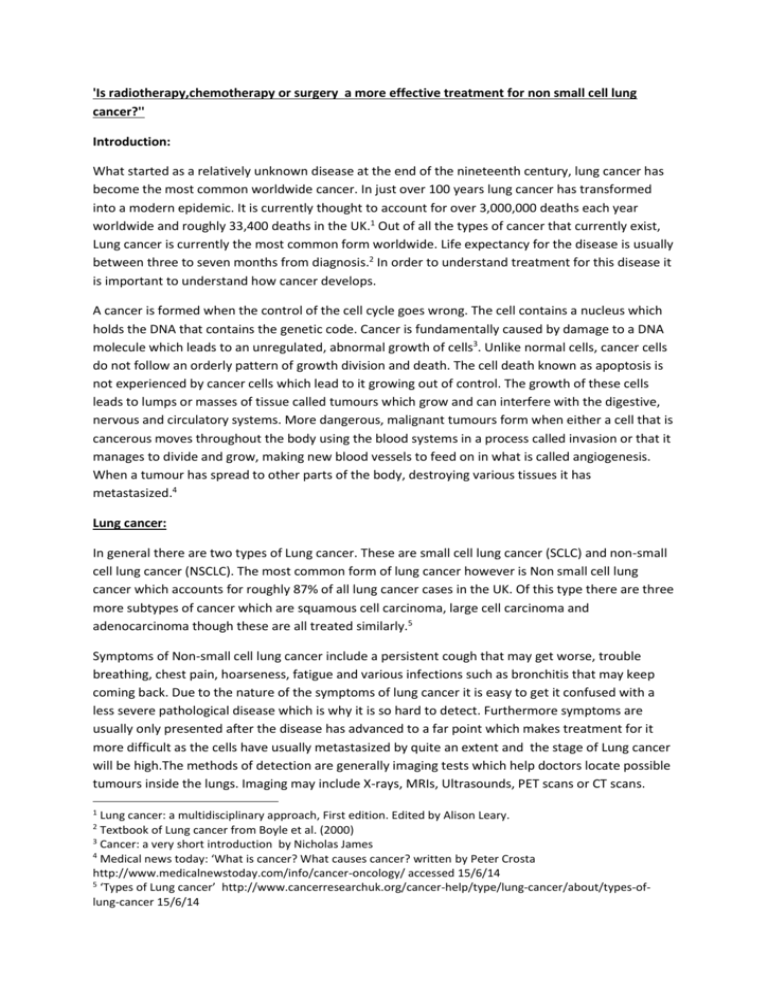
'Is radiotherapy,chemotherapy or surgery a more effective treatment for non small cell lung cancer?'' Introduction: What started as a relatively unknown disease at the end of the nineteenth century, lung cancer has become the most common worldwide cancer. In just over 100 years lung cancer has transformed into a modern epidemic. It is currently thought to account for over 3,000,000 deaths each year worldwide and roughly 33,400 deaths in the UK.1 Out of all the types of cancer that currently exist, Lung cancer is currently the most common form worldwide. Life expectancy for the disease is usually between three to seven months from diagnosis.2 In order to understand treatment for this disease it is important to understand how cancer develops. A cancer is formed when the control of the cell cycle goes wrong. The cell contains a nucleus which holds the DNA that contains the genetic code. Cancer is fundamentally caused by damage to a DNA molecule which leads to an unregulated, abnormal growth of cells3. Unlike normal cells, cancer cells do not follow an orderly pattern of growth division and death. The cell death known as apoptosis is not experienced by cancer cells which lead to it growing out of control. The growth of these cells leads to lumps or masses of tissue called tumours which grow and can interfere with the digestive, nervous and circulatory systems. More dangerous, malignant tumours form when either a cell that is cancerous moves throughout the body using the blood systems in a process called invasion or that it manages to divide and grow, making new blood vessels to feed on in what is called angiogenesis. When a tumour has spread to other parts of the body, destroying various tissues it has metastasized.4 Lung cancer: In general there are two types of Lung cancer. These are small cell lung cancer (SCLC) and non-small cell lung cancer (NSCLC). The most common form of lung cancer however is Non small cell lung cancer which accounts for roughly 87% of all lung cancer cases in the UK. Of this type there are three more subtypes of cancer which are squamous cell carcinoma, large cell carcinoma and adenocarcinoma though these are all treated similarly.5 Symptoms of Non-small cell lung cancer include a persistent cough that may get worse, trouble breathing, chest pain, hoarseness, fatigue and various infections such as bronchitis that may keep coming back. Due to the nature of the symptoms of lung cancer it is easy to get it confused with a less severe pathological disease which is why it is so hard to detect. Furthermore symptoms are usually only presented after the disease has advanced to a far point which makes treatment for it more difficult as the cells have usually metastasized by quite an extent and the stage of Lung cancer will be high.The methods of detection are generally imaging tests which help doctors locate possible tumours inside the lungs. Imaging may include X-rays, MRIs, Ultrasounds, PET scans or CT scans. 1 Lung cancer: a multidisciplinary approach, First edition. Edited by Alison Leary. Textbook of Lung cancer from Boyle et al. (2000) 3 Cancer: a very short introduction by Nicholas James 4 Medical news today: ‘What is cancer? What causes cancer? written by Peter Crosta http://www.medicalnewstoday.com/info/cancer-oncology/ accessed 15/6/14 5 ‘Types of Lung cancer’ http://www.cancerresearchuk.org/cancer-help/type/lung-cancer/about/types-oflung-cancer 15/6/14 2 Once a tumour has been discovered the main treatment options for NSCLC are surgery, radiotherapy and chemotherapy.6 Surgery: For patients with Stage I or II of the disease, surgery gives the best chance of a cure although it is quite hard to detect Non-small cell lung cancer in its early stages. In attempting surgery the doctor will perform a thoracotomy, which involves leaving an opening in the chest wall. This leaves a scar around the side of the chest. The surgeon will then identify and agree upon a method of pain control which is important for the patient’s comfort. This will most likely involve local anaesthesia and medication with paracetamol. On the whole there are three main types of surgery for non-small cell lung cancer which include a Lobectomy, Pneumonectomy and a wedge resection. Lobectomy involves getting surgically removing half of or the whole section of a lung. Lobectomy Pneumonectomy Wedge resection Pneumonectomy is the removal of a whole lung as shown in the diagram above. Despite the impression that it will be difficult to cope without a lung, it is possible to breathe normally with only one lung present but only if there were no previous breathing difficulties pre-operation. Finally a wedge resection can take place if the cancer is not far enough which involves removing only a small portion of the lungs. Surgery is usually combined with chemotherapy and radiotherapy to achieve the best effect. Soon after the patient will be able to go home but they will only get fully better a long while after the operation takes place. If a Pneumonectomy has been performed then the patient will have to check in with his/her local doctor to check that breathing difficulties are not present. Surgery does provide clear benefits, the main one being that it can eradicate the tumour if it is localised in a small area. The five year survival rate with surgery alone approaches to 60-70%7 if the patient presents an early stage localized disease. Unfortunately most patients present symptoms that are in the range of stage III to IV since detection rate is low at early stages. The drawbacks of surgery are that usually there are common side effects after which include the chest being sore and feeling short in breath due to the lack of lung tissue. In severe cases pneumonia and bleeding can 6 ‘Non-small Cell Lung cancer’ by Winston W tan http://emedicine.medscape.com/article/279960-overview accesed 15/6/14 7 Lung cancer by Frank V Fosella et al. occur as a result of this surgery or a leak of air from the lung wall. DVT (deep vein thrombosis) is also a side effect of surgery and further surgery and medicine is likely to be used to overcome these issues. Furthermore if the cancer has metastasized to multiple tumours in a stage IV lung cancer condition then surgery is unlikely to be effective but is still possible if they are all localised close to each other and they have not spread to other internal organs. Radiotherapy: Radiotherapy is the use of ionising radiation to kill cells. It is packets of energy which takes several forms of photons such as x-rays or gamma rays. It can also be particles i.e. protons, electrons or neutrons. Radiation deposits energy in tissues and produces ionisation. Radiation kills cells by producing secondary charged particles and free radicals in the cell nucleus which produce a form of DNA damage. DNA can be damaged when high energy x-rays collide with electrons of the biological molecules which causes the electrons of these molecules to be ejected. This leads to DNA damage which causes cells to die almost immediately.8 Radiotherapy is carried out via intensive radiation therapy which involves a thin wire being sealed in an object and placed in a catheter which is inserted into the lungs via the bronchi. It is then placed at the site of the tumour and is left there for several minutes until removal so as to maximise the effect of it killing cancer cells but not to leave it too long to damage normal tissue. The doses of radiation are usually split into smaller doses per session with a doctor. This process is known as fractionation, and the dose is gradually increased as treatment progresses in order to achieve the same amount of cell kill. The most desirable use of radiotherapy involves using generally lower doses per fraction to kill the cancer cells but allow the normal cells to recover. Methods of delivering radio treatment include Brachytherapy that is delivered by placing a source of radiation next to the treatment area, in this case the lungs. Due to their precisely placed position the irradiation only affects a localised area of the lungs so healthy tissues are less exposed to harmful radiation. This has advantages to external beam radiation therapy since the tumour will be treated with localised radiation that lowers the probability of damage to surrounding tissue9. Since brachytherapy is completed in a lower amount of time than other radiation therapy courses it lowers the chance of lung cancer cells surviving and dividing between doses of radiation which increases the chance for patient survival as a result. External beam therapy, the alternative method for delivery of radiation uses electron beam therapy, orthovoltage and megavoltage therapy. Orthovoltage produces low energy beams of x rays that treat tumours since the dose of radiation is within a few centimetres of the skin. Electron beam therapy is delivered using a linear accelerator which fires charged particles (electrons) towards the site of the tumour after the area of the cancer has been marked on the patient’s skin. Megavoltage is below the skin surface which allows the skin to be spared of damage from the radiation and is used to treat deep seated tumours. Radiotherapy has clear advantages as it is seen as a last resort for those medically inoperable due to the location or size of their tumour. Radiotherapy is a painless procedure (though the side effects 8 ‘Lung Cancer a multidisciplinary approach’ by Alison leary page 67 9 Stewart AJ et al. (2007). "Radiobiological concepts for brachytherapy". may be painful) that helps prevent the spread of cancer cells in the body and is super effective due to its precise localised nature in being able to treat the cancer. As a result of new technology computer imaging can help locate the tumour and assist machines in administering localised radiation which can be more effective since the target area is pinpointed easily so the damage to surrounding tissue is minimised. Although it is effective in destroying a tumour there are several side effects of radiotherapy. It can cause tiredness and also chest pain and flu-like symptoms. The side effects range from the mild to the more severe depending on how strong the radiation dose that you have taken is. Radiothearpy will occasionally cause the oesophagus to become inflamed which consequently leads to problems with swallowing and being uncomfortable. A further side effect would include tiredness due to loss of cells.10 External radiotherapy can also cause extreme side effects since the radiation used damages healthy tissues which can lead to chest pain. Further disadvantages include the expensive nature of radiotherapy as it involves the use of high tech machinery, lots of different sessions, several registered practitioners monitoring your progress and lots of different treatments. The cost therefore is high and this too can also vary depending on the cost of the health service in your area which you may not be able to afford. Also there are restrictions to the diet of a patient which require that they eat lots of calories so they don’t lose weight during treatment. After radiotherapy has finished the patient will need to have care for the rest of his life as checkups will be carried out to check for signs of the cancer or whether the therapy has worked, which it might not have. Chemotherapy: Chemotherapy is considered to be relatively insensitive to non-small cell lung cancer but is used in combination with radiotherapy and surgery anyway since it does have an effect although a minor one anyway. Chemotherapy is a treatment involving the use of drugs to prevent the growth of cancer cells in the lungs which is done either by killing the cells or to stop them from dividing. Chemotherapy is usually taken in orally or intravenously since it can enter the bloodstream and reach the cancer cells throughout the body. When it is placed directly into an organ such as the lungs the drugs affect the cells in that area. The method of delivery for these drugs depends on the stage of the non-small cell lung cancer present at the time of patient treatment.11 The drugs then travel through the bloodstream at a rapid rate and destroy cell micrometastases and the spread of cancer cells which cannot be detected by scans since they have moved away from the tumour and are too small to see. This makes the treatment somewhat effective in eliminating cancer cells from other parts of the body which is why it is readily prescribed as a means of treatment for patients with stage iv of NSCLC and this is good because at this stage the cancer has been spread to other parts of the body and so is effective in tackling this issue as after the cancer has spread to the other parts of the body it is hard to control and monitor it so chemotherapy helps diminish the effect that the cancer cells have when it has spread to the other areas. 10 ‘Radiotherapy for non small cell lung cancer’ accessed 15/6/14 http://www.macmillan.org.uk/Cancerinformation/Cancertypes/Lung/Treatingnonsmallcelllungcancer/Radiotherapy.aspx 11 http://www.cancer.gov/cancertopics/pdq/treatment/non-small-cell-lung/Patient/page4#Keypoint23 Chemotherapy improves significantly 1-year survival for patients with advanced NSCLC. It is mostly recommended for patients with either stage iii or stage iv of NSCLC. The treatment is generally known as combination chemotherapy since a combination of drugs are taken which are docetaxel and gemcitabine which are the major drugs used. It is important to note that most chemotherapy drugs have an existing toxicity which makes choosing the dosage an important job as too low a dose would be too ineffective yet too high a dose could damage cell tissue seriously and could lead to side effects. Chemotherapy is often used after surgery to lower the risk of the cancer coming back. The treatment of chemotherapy and radiotherapy together is sometimes used to banish the early stages of Non small cell lung cancer for those who are not able to have a surgery. For a healthy person the best chance of survival is a combined therapy of chemotherapy and radiotherapy since they will be able to potentially maximise the effect of survival and although being cured is unlikely it will certainly help to live longer. The two approaches of taking chemotherapy in patients have been preoperative (neoadjuvant) and postoperative (adjuvant). Studies have been conducted on adjuvant treatment but no real benefit was discovered from patients with this treatment despite the stage they were in proving it to be relatively ineffective. A study was conducted on 52 randomized trials where adjuvant chemotherapy was utilized in patients with the disease and there was only a 5% positive treatment effect and in some cases it was even considered detrimental to overall survival.12 Neoadjuvant treatment has also been studied by scientists and has been shown to have demonstrated a significant survival benefit to patients with around a stage III disease of non small cell lung cancer that has had its preliminary results been approved of. In contrast to radiotherapy and surgery, chemotherapy is a systemic treatment used to treat the entire body rather than a small area. Chemotherapy drugs vary widely in composition, administration and side effects. Cancer is made of living tissue, so the destruction of cancer depends on the destruction of its cells. Chemotherapy destroys either cancerous and normal cells which is unavoidable, therefore it is not recommended for unfit people or people who are very weak since it will make them more unfit and maybe ill. Every time chemotherapy is administered there needs to be a compromise between the destruction of the cells of cancer and the control of undesirable side effects. Chemotherapy has certain benefits for patients and that would be that it can be used to control the growth of tumours and to prevent it spreading throughout the body and metastasizing though it cannot be considered an effective cure since the cancer will resurface. It can however make the area of cancer small enough so that a team of surgeons can operate on the tumour which makes it work very effectively when combined with the use of surgery or radiotherapy. It is also beneficial since it reduces the other symptoms of the cancer which include the patient’s stress due to being hurt by the cancer. Reducing stress and pain can be significantly important since it increases his quality of life which is most important when considering a patient and his needs even though he is unable to be cured from the cancer. 12 Lung cancer by Frank V fosella The disadvantages presented from the use of chemotherapy in the treatment of non small cell lung cancer are much more severe. Most people experience tiredness that gets worse as the treatment progresses and will even last for quite a few months after the treatment has ended known as fatigue. Patients will lack energy and will struggle to cope with excessive feelings of tiredness as a result of the chemotherapy which will cause it. Furthermore chemotherapy stops the bone marrow from making enough blood cells to be produced. This means that white blood cell production is significantly reduced so the patient is more prone to infection due to low white blood cell count, the patient is anaemic due to low red blood cell count and the patient is at risk of severe bleeding due to the lack of platelets to help clot the blood and thus prevent excessive bleeding from occurring. Signs of infection amongst patients will include a high temperature, headache, coughs and a fever. 13 Most commonly observed amongst chemotherapy patients and cancer patients in general are a loss of hair. Some drugs make your hair fall out by making it thinner while other make all your hair fall off including the eyebrows and the eyelashes. Hair loss is very distressing for the patient’s self esteem and can be one of the worst side effects encountered since most patients can’t cope without their hair. Furthermore chemotherapy also makes the skin more sensitive and dry which causes rashes and increased risk of sunburn when exposed to the sun for too long. People often find that nails become brittle during treatment and the hair is found with white streaky lines going straight through it. The mouth can also be affected since it can become quite sore with bulges developing on the side of it. A final disadvantage is that chemo drugs can damage nerves and cause pins and needles in your hands and feet. Conclusion: It is difficult to conclude which treatment is most effective since the treatments listed are the main treatments for the disease and are usually used in combinations with each other. Surgery is an immediately effective short term solution for treating localised areas of the cancer but in roughly 40% of cases lung cancer is inoperable and this is not a viable solution, therefore a combination of chemotherapy and radiotherapy is used as treatment. Surgery can allow the 5 year survival rate for a patient to greatly increase however the cancer will inevitably return and surgery will no longer be a viable option as a significant portion of the lung has been cut out at this point. Chemotherapy is fairly effective though is almost useless on its own neoadjuvant or adjuvant but combined with radiotherapy is effective in preventing the cancer cells from metastasizing and for the tumour to spread which makes it useful but only as a combination with another option. The side effects of chemotherapy alone make it an undesirable option to be used by itself and therefore are the weakest of my three proposed methods. Finally I believe radiotherapy to be the most effective solution for the treatment of non-small cell lung cancer since it is both a localised form of cancer treatment that also prevents metastatisation of the tumour to other parts of the body without posing the same risks as surgery. Although a lot of tumours are considered surgically inoperable due to their position in the lungs, radiotherapy is often considered to be able to treat all tumours since the charged particles can penetrate anywhere in the body without an incision needing to be made in order to reach the tumour. 13 http://www.cancerresearchuk.org/cancer-help/about-cancer/treatment/chemotherapy/chemotherapyside-effects

